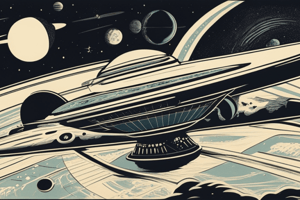Podcast
Questions and Answers
Apa yang dimaksud dengan planet gas giants?
Apa yang dimaksud dengan planet gas giants?
Planet di luar empat planet terluar, terdiri dari Jupiter, Saturnus, Uranus, dan Neptunus, yang utamanya terdiri dari hidrogen dan helium.
Apa yang membuat Jupiter terkenal?
Apa yang membuat Jupiter terkenal?
Jupiter terkenal karena Great Red Spot-nya, yaitu badai besar yang berlangsung selama berabad-abad.
Apa yang menjadi ciri khas Saturnus?
Apa yang menjadi ciri khas Saturnus?
Saturnus terkenal karena sistem cincinnya yang terbuat dari es, debu, dan batu.
Mengapa Uranus mengalami musim yang ekstrem?
Mengapa Uranus mengalami musim yang ekstrem?
Apa yang menyebabkan warna biru dalam atmosfer Neptunus?
Apa yang menyebabkan warna biru dalam atmosfer Neptunus?
Flashcards are hidden until you start studying
Study Notes
The Solar System: A Cosmic Neighborhood
Our solar system is a remarkable cosmic neighborhood located within the Milky Way galaxy. It consists of the sun and all the celestial bodies that orbit around it. These include eight planets, five dwarf planets, hundreds of moons, numerous asteroids, and various comets. Let's delve deeper into the fascinating world of our solar system.
The Planets
Terrestrial Planets
The inner four planets, starting from the sun, are known as the terrestrial planets. They are primarily composed of rock and metal. Here's an overview of these four planets:
- Mercury: The smallest planet in our solar system and closest to the sun, Mercury experiences extreme temperature variations between its hot side facing the sun and its freezing dark side.
- Venus: Often referred to as Earth's sister planet, Venus shares similarities in size and composition. It has a thick atmosphere filled with greenhouse gases, resulting in surface temperatures hot enough to melt lead.
- Earth: Our home planet is known for its unique features that support life, including liquid water on the surface and a breathable atmosphere. Earth's diverse ecosystems make it a thriving environment for numerous species.
- Mars: Known as the Red Planet, Mars has a thin atmosphere consisting mostly of carbon dioxide. It has polar ice caps made up of water and carbon dioxide, creating seasons similar to those on Earth.
Gas Giants
The outer four planets, beyond the orbit of Mars, are classified as gas giants. These planets are primarily composed of hydrogen and helium, with smaller amounts of other elements:
- Jupiter: The largest planet in the solar system, Jupiter is famous for its Great Red Spot, a massive storm that has been ongoing for centuries.
- Saturn: Best known for its prominent ring system made of ice, dust, and rocks, Saturn is the second-largest planet in the solar system.
- Uranus: An icy planet tilted on its axis, Uranus experiences extreme seasons due to its axial tilt.
- Neptune: The farthest planet from the sun, Neptune is characterized by strong winds and a deep blue color caused by methane in its atmosphere.
Dwarf Planets
Previously considered the ninth planet, Pluto was reclassified as a dwarf planet in 2006. Alongside Pluto, there are three other dwarf planets in the Kuiper Belt region of the solar system.
Moons and Other Bodies
Our solar system hosts thousands of moons orbiting various celestial bodies. These natural satellites play crucial roles in maintaining stable orbits and providing valuable scientific data about their parent planets. Additionally, countless asteroids, comets, and meteoroids exist within the solar system, contributing to the ongoing study of cosmic phenomena.
In conclusion, the solar system represents a vast and intriguing collection of celestial objects, each with unique characteristics and properties. From the inner terrestrial planets to the outer gas giants, and from dwarf planets to moons and other small bodies, every part of our solar system contributes to our understanding of the universe and our place within it.
Studying That Suits You
Use AI to generate personalized quizzes and flashcards to suit your learning preferences.




